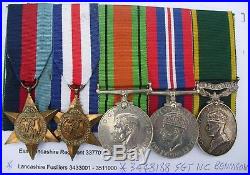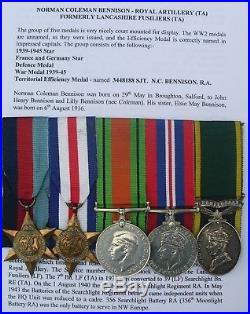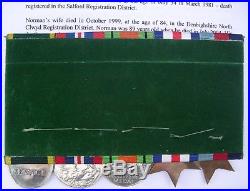


NORMAN COLEMAN BENNISON – ROYAL ARTILLERY (TA). FORMERLY LANCASHIRE FUSILIERS (TA). The group of five medals is very nicely court mounted for display. The WW2 medals are unnamed, as they were issued, and the Efficiency Medal is correctly named in impressed capitals. The group consists of the following. France and Germany Star. Territorial Efficiency Medal – named 3448188 SJT. PLEASE CHECK OUT MY OTHER LISTINGS FOR MANY MORE INTERESTING ITEMS, INCLUDING ORIGINAL WW1 MEDAL RIBBON AND MORE WW2 MEDAL GROUPS WITH A NAMED MEDAL. Norman Coleman Bennison was born on 29th May 1915 in Broughton, Salford, to John Henry Bennison and Lilly Bennison (nee Coleman). His sister, Elsie May Bennison, was born on 6th August 1916. Norman married Elsie Booth in Salford in September 1939. The couple had two sons. Raymond V Bennison was born in the second quarter of 1945. He married Deirdra M Taylor in the Salford Registration District in the third quarter of 1971. A daughter was born in 1976 and a son was born in 1982 (the son was given his late uncles name as his middle one). Graham Bennison was born in the final quarter of 1946 in the Heywood Lancashire Registration District. He married Christine S Bradburn in the Barton Greater Manchester Registration District in the second quarter of 1969. Two daughters were born in 1970 and 1974. Graham died at the age of only 34 in March 1981 – death registered in the Salford Registration District. Normans wife died in October 1999, at the age of 84, in the Denbighshire North Clwyd Registration District. Norman was 89 years old when he died in July 2004. His death was registered in the same District as his wife. Turning to his army service. In brief:- #. The Efficiency Medal was issued after 12 years of service (war service counted as double) by which time he had reached the rank of sergeant and was serving in the Royal Artillery. The Service number is from a block allotted to The Lancashire Fusiliers (LF). LF (TA) in 1936 was converted to 39 (LF) Searchlight Bn. On the 1 August 1940 the Bn became a Searchlight Regiment RA. In May 1943 the Batteries of the Searchlight Regiment became came independent units when the HQ Unit was reduced to a cadre. 356 Searchlight Battery RA (356th Moonlight Battery RA) was the only battery to serve in NW Europe. #The 356th Moonlight Battery, Royal Artillery. #The 356th Moonlight Battery, Royal Artillery was a searchlight unit of the British Army that provided artificial illumination, or’Monty’s Moonlight’, for night operations by 21st Army Group during the campaign in North West Europe in 194445. In the 1930s the increasing need for anti-aircraft (AA) defence for Britain’s cities was addressed by converting a number of Territorial Army (TA) infantry battalions into searchlight battalions of the Royal Engineers (RE). The 7th Bn Lancashire Fusiliers was one unit selected for this role, becoming 39th (The Lancashire Fusiliers) AA Battalion, RE in 1936. Consisting of HQ and four AA companies (354357) at the Drill Hall, Cross Lane, Salford. The TA’s AA units were mobilised on 23 September 1938 during the Munich Crisis, with units manning their emergency positions within 24 hours, even though many did not yet have their full complement of men or equipment. The emergency lasted three weeks, and they were stood down on 13 October. In February 1939 the existing AA defences came under the control of a new Anti-Aircraft Command. In June, as the international situation worsened, a partial mobilisation of the TA was begun in a process known as’couverture’, whereby each AA unit did a month’s tour of duty in rotation to man selected AA gun and searchlight positions. This deployment to guard Vital Points (VP) continued through the period known as the’Phoney War’ until the company was fully equipped with searchlights. On 1 August 1940 the AA battalions of the RE were transferred to the Royal Artillery (RA), the 39th being designated 39th (The Lancashire Fusiliers) Searchlight Regiment, RA, and the Companies became Batteries. The day of the formal transfer happened to be Minden Day, celebrated in all battalions of the Lancashire Fusiliers by wearing red roses. 356 Battery held a parade at Salford. Despite transfer to the RE and then the RA, the regiment and its batteries continued to wear their Lancashire Fusiliers’ cap badges and buttons. Shortly afterwards, 355 and 356 Batteries went to Orkney, where they formed part of Orkney and Shetland Defences (OSDEF) guarding the vital Scapa Flow naval base against occasional Luftwaffe nuisance raids and reconnaissance aircraft. They were later joined by Regimental HQ. The newly arrived searchlight crews were continuously in action, some stationed in the docks area that was a particular target of these raids. In mid-November 1941 the regiment was redeployed, with 356 Bty moving to east Preston. In November 1942, 356 Battery handed over its searchlight sites and went into training prior to becoming an independent battery for overseas service. By January 1943, 356 Bty had completed mobile and battle training, and was temporarily attached to 59th S/L Rgt manning sites near Edinburgh. By May 1943 the threat from German air raids had receded, and a number of searchlight units were reduced or converted to other roles. 39th S/L Regiment HQ was reduced to a cadre and took no further part in the war. By this time, the battery had been designated 356 (Independent) Searchlight Battery, RA but continued to wear Lancashire Fusiliers’ badges and buttons. In April and May 1943 the battery underwent mobile training at Kinloss in Scotland and at Thurstaston on the Wirral, then in June it moved to Margate in Kent to begin training in cooperation with heavy anti-aircraft (HAA) guns under 74th AA Brigade, one of the formations preparing for Operation Overlord, the planned Allied invasion of Normandy. In the autumn it moved toNorthampton and later Warwick, using Air Defence of Great Britain searchlight positions for training in cooperation withRoyal Air Force night fighters and providing’Canopy’ coverage over VPs such as airfields. In February 1944, 356 S/L Bty came under the command of 105th AA Brigade (another Overlord formation). In April the battery painted white Allied stars on its vehicles and moved to Southend-on-Sea for final preparations for the invasion; meanwhile its S/L crews were deployed to provide’Canopy’ coverage at RAF Twinwood Farm and RAF Coltishall. Late in the month, the whole battery moved into sealed camps in the invasion force’s concentration area. Battery HQ and advanced parties of the S/L Troops embarked on LSTs at Southampton between 31 May and 4 June, and began landing on the King Beach sector of Gold Beach late on D-Day (6 June), although they were unable get any searchlights ashore before darkness fell. A Troop had seven lights (out of a planned 16) in operation by 20.30 on D + 1, in time for an air raid at 23.30. The first light exposed, A3,’went straight up on a Ju88′. The following night, with 15 lights in action, B6 caught a Heinkel He 111 and passed it to a succession of S/Ls while all the AA guns on land and sea fired, bringing it down in flames. [14] The battery was operating under 76th AA Brigade, responsible for the AA defence of the Gold beachhead, the Mulberry harbour under construction at Arromanches, and the oil terminal at Port-en-Bessin. C Troop and the remainder of the frontline elements of the battery arrived on Motor Transports from Southend on 9 June (D + 3), but the vehicles could not be landed until the next day. The Royal Electrical and Mechanical Engineers workshop, Royal Corps of Signals section and rear echelon vehicles did not arrive until some weeks later. Over succeeding nights the S/Ls were in use against nuisance raids over the beachhead, with some casualties suffered from the bombing. The lights forced the Luftwaffe to attack from greater height. From 14 June the battery also operated one S/L as an’Orbit’ beacon for RAF night fighters. On 12 July (D + 36) the routine for 356 Bty was broken when it was ordered to send three S/L detachments to cooperate with 474 (Ind) S/L Bty in providing’artificial moonlight’ for a tank concentration in the forward area. Apart from AA defence, mobile 90 cm searchlights were used in the North West Europe campaign to reflect light off the cloudbase to provide artificial moonlight or’movement light’ (also known as’Monty’s moonlight’, after the commander of 21st Army Group, Gen Bernard Montgomery) in support of night operations. After the test carried out by 356 and 474 Btys, the newly arrived 344th (Ind) S/L Bty used the technique operationally for the first time to assist the assembly of 15th (Scottish) Division for Operation Greenline on the night of 14/15 July. Meanwhile, S/L positions were in action nightly, and during the day were frequently subject to ground attack, to which they responded with Light machine guns. S/L detachments were routinely equipped with Bren guns for close AA defence, but in July they began to receive 20 mm Polsten guns. On 26 July the eight S/Ls of B Troop were sent to operate round the recently captured town of Caen under command of 100th AA Brigade. The bridges over the Caen canal were under regular night air attack, causing casualties among the S/L crews, and the S/L positions were also under shellfire. B Troop was relieved by 557 (Ind) S/L Bty at the end of July. After 21st Army Group’s breakout from the Normandy beachhead at the end of August 1944, AA units began leap-frogging forwards. By 4 September, 76th AA Bde, including 356 Bty, was relieving the frontline troops in providing AA defence for Amiens and along the River Somme. The battery was relieved in turn on 22 September, and moved up to reinforce 107th AA Brigade in the Siege of Dunkirk. Here the task was to counter Luftwaffe bombers attempting to drop supplies to the German garrison. 356 S/L Bty was withdrawn from the Dunkirk siege lines on 1 November, and on 10 November a troop of the battery joined 74th AA Bde guarding Grave bridge. By the end of the month, two troops were at the Grave and Mook bridges, while Battery HQ and the remainder of the battery were with 106th AA Brigade guarding river and canal crossings at Geleen and Maastricht in XXX Corps’ area. From 17 December until 344 Bty relieved 356 Bty on 22 December, there was increased enemy air activity over the Maas bridges in connection with the German Ardennes Offensive. At the beginning of January 1945, 356 Bty moved to Namur to join 106th AA Bde supporting XXX Corps for the forthcoming Operation Veritable. A Troop provided artificial moonlight to assist bridgebuilding by the sappers of 6th Airborne Divisionand the battery provided low-intensity movement light for the Corps assembly areas. When Veritable opened on 9 February, 356 Bty also had 557 Bty under its command, with one troop supporting 3rd Canadian Division and the other two providing movement light on the roads. For the attacks on the Siegfried line(Westwall) bunkers, which took place on the night of D/D +1, part of the Klever Reichswald was floodlit, and some S/L positions were sited with the intention of dazzling the defenders while lighting up the obstacles. After their success in Veritable, 356 and the other S/L batteries providing movement light were redesignated’Moonlight’ batteries and assigned to corps. 356th Moonlight Battery continued with XXX Corps, whose commander, Lt-Gen Brian Horrocks, had highly commended the battery. The whole battery, together with Horrocks and his Corps Commander Royal Artillery, resisted the transfer, and the battery continued planning for Plunder’as if nothing had happened’, while taking the precaution of refitting its lights with AA radar. Members of the battery were given permission to wear the XXX Corps wild boar (or’Old Pig’) shoulder flash for the Rhine crossing. Trials of various S/L arrangements were carried out on the River Maas, and the plan decided on was for four banks of lights, one behind the assembly areas, two interspersed among them, and one well forward, close to the west bank of the river, a total of 33 S/L projectors per corps. As part of the deception plan, artificial moonlight was deployed randomly along the Rhine for some nights prior to the assault, to accustom the Germans to it. A, B and C Troops were assigned to go forward with 43rd (Wessex) Division, Guards Armoured Division and 51st (Highland) Division respectively, while 582 M/L Bty, under operational command of 356 Bty, was with XXX Corps HQ. H-Hour for Plunder was 21.00 on 23 March, and at first only C Troop supporting 51st (Highland) Division was committed, with its radio communications assisted by reconnaissance cars of the Derbyshire Yeomanry. The assault waves of amphibious Buffaloes and DD Shermans began moving down to their crossing points under the movement light. By 27 March, after the success of the crossings, A and C Troops were operating on the east side of the river. The Luftwaffe made determined efforts to destroy the bridges being built behind the assault troops, and were engaged at night by AA fire directed both by searchlight and by radar. On 29 March, 356 Bty did finally transfer to 107 AA Bde for AA defence of the II Canadian Corps crossing at Emmerich, except A Troop, which continued in the movement light and’fighting light’ role with 43rd (Wessex) Division as it advanced into Germany. By mid April the Rhine was already a’back area’, and 107 AA Bde advanced with the Canadians to the coast. On 24 April, 356 deployed Troops and Sections with batteries from 109th HAA Regiment to light and control the channels into the port of Emden. The battery was under the command of 5th Canadian Armoured Division when the German surrender at Lüneburg Heath came on 4 May. The War Diary reports on 1 August 1945 that’Minden Day was celebrated as well as it was possible to do so with the Bty so widely deployed’. Shortly afterwards the battery was demobilised. The item “RESEARCHED WW2 TERRITORIAL MEDAL GROUP SJT BENNISON RA LATE LANCASHIRE FUSILIERS” is in sale since Wednesday, August 1, 2018. This item is in the category “Collectables\Militaria\World War II (1939-1945)\Medals/ Ribbons”. The seller is “dave7gr1″ and is located in Hereford. This item can be shipped to United Kingdom, Austria, Belgium, Bulgaria, Croatia, Cyprus, Czech republic, Denmark, Estonia, Finland, France, Germany, Greece, Hungary, Ireland, Italy, Latvia, Lithuania, Luxembourg, Malta, Netherlands, Poland, Portugal, Romania, Slovakia, Slovenia, Spain, Sweden, Australia, United States, Canada, Brazil, Japan, New Zealand, China, Israel, Hong Kong, Norway, Indonesia, Malaysia, Mexico, Singapore, South Korea, Switzerland, Taiwan, Thailand, Saudi arabia, South africa, United arab emirates, Ukraine, Chile.
- Issued/ Not-Issued: Issued
- Service: Army
- Era: 1914-1945
- Type: Medals & Ribbons
- Country/ Organization: Great Britain
- Country/Region of Manufacture: United Kingdom
- Conflict: World War II (1939-1945)